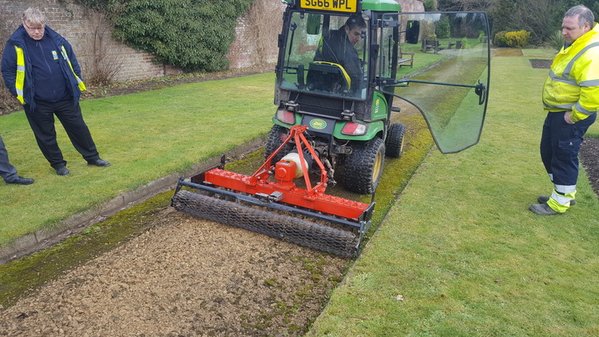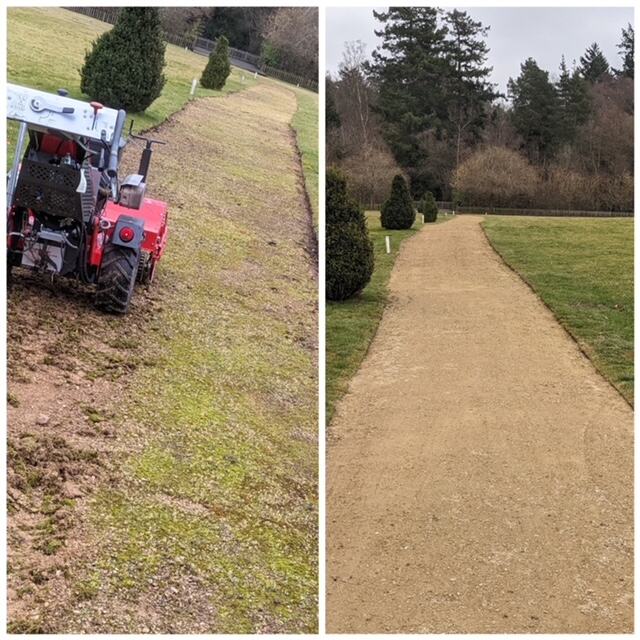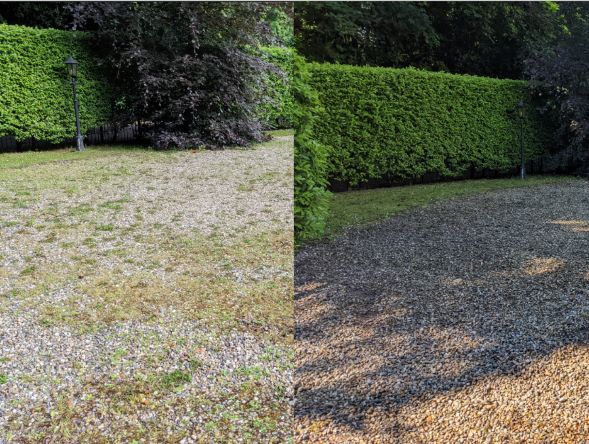Gravel Surface Maintenance

Gravel Surface Maintenance
Effective Gravel Surface Maintenance: Solutions for Longevity and Functionality
Gravel surfaces are popular for driveways, church gravel yards, and rural roads due to their versatility and aesthetic appeal. However, they often face issues such as compaction and detritus buildup, which can lead to uneven surfaces, puddling, and moss and weed growth. Regular maintenance is essential to prevent these problems and ensure your gravel paths remain functional and visually appealing. Discover expert tips and effective tools for maintaining gravel surfaces and keeping them in top condition.
Compacted surfaces contribute to weeds and moss growing on the gravel road
Gravel is a porous, low maintenance surface that has both functional and aesthetic appeal. But when a gravel path surface lacks maintenance, the heavily used gravel surfaces become compacted. With the debris and detritus trapped in between the gaps of the gravel, it becomes a nutrient rich, damp environment for weeds and moss to grow.
Heavy traffic can easily compact gravel, leading to uneven surfaces, puddling, and even flooding during rain. To prevent these problems, a gravel path renovator can be used to loosen compacted gravel. Its specialized knives cut under the roots of moss and weeds, lifting them to the surface for easy removal by raking or blowing.
Weed burning can also serve as an effective spot treatment for gravel surfaces, particularly once detritus and weeds have been cleared. This combined approach helps to maintain the gravel's appearance and performance for longer periods.
Articles about Gravel Surface Maintenance
The detritus build up on the hard surfaces would block up the drainage, leading to water accumulated on the surface. To minimise soil build up, we suggest implementing a preventive maintenance regime, including regular sweeping, tree trimming, grass cutting, and integrating blowers into the maintenance routine. This minimises the soil build up while mitigating the need for extensive remedial work.
Over time, surfaces may become compacted, leading to reduced drainage and increased weed growth. When this occurs, it's important to take action before the problem worsens.
For compacted gravel paths, use the Gravel Path Renovator. This tool works by:
- Cutting through weed roots, disrupting their growth.
- Lifting compacted soil to the surface, breaking up the dense layer.
- Restoring the structure of the gravel, ensuring better drainage and appearance.
Clear Surface with Blower:
Once the renovator has lifted the soil and weeds, use the blower again to remove the loosened debris. This will leave the surface clean, well-drained, and free from obstructions.
Repairing potholes and maintaining the correct camber on gravel surfaces is crucial for ensuring long-lasting durability and preventing costly damage. Gravel paths, commonly used for driveways, hiking trails, and garden paths, can develop potholes over time due to heavy traffic, rain, and surface compaction. Without proper camber, water can't drain effectively, leading to erosion and further deterioration.
To fix potholes and restore the camber, using a Grader is an efficient and cost-effective solution. The HK Grader redistributes the existing gravel, filling in potholes and leveling the surface with its HARDOX scraper bar, reducing the need for expensive new materials. Its angled distributor blade helps reshape the path's camber, allowing for optimal water drainage, preventing puddling and erosion.
Watch this Kersten Kombi Grader Removing potholes and restoring Path Camber
Flooding and puddles often occurs due to surface compaction, which prevents water from draining properly. Rake or de-compact the gravel to improve drainage, Kersten Gravel Path Renovators can loosen even heavily compacted gravel surfaces allowing them to drain again.
Gravel yards are prone to weed growth due to several factors like detritus build-up, compacted gravel, and inadequate weed control practices. Over time, organic material such as leaves, twigs, and soil accumulate in the gravel, creating a nutrient-rich environment for weeds to grow. Additionally, if the gravel layer is too thin or not regularly maintained, weeds can establish themselves more easily.
Solutions to Prevent Weed Growth in Gravel Yards:
- Regular Raking and De-compaction: Loosen the gravel regularly using a rake or a gravel path renovator to prevent surface compaction. Compacted surfaces trap moisture and detritus, promoting weed growth. Keeping the surface loose will improve drainage and hinder weed establishment.
- Detritus Removal: Detritus like leaves and grass clippings should be regularly removed. Use a leaf blower or a rake to clean the surface, preventing organic material from breaking down into soil, which serves as a seedbed for weeds. Also, you can prune dead branches on nearby trees and collect grass clippings on the border of the gravel.
- Weed Control Methods: For existing weeds, you can either physically remove them or use weed-burning techniques. Ripagreen can spot-treat weed-infested areas effectively, eliminating the problem without resorting to chemical herbicides.
- Mechanical Maintenance: For a more sustainable solution, using tools like the gravel path renovator and HK Grader can help manage both detritus build-up and compaction. The machine lifts the roots of the weeds and redistributes gravel, restoring the surface and preventing future growth.
By implementing these practices, you can significantly reduce weed growth and maintain a clean, weed-free gravel yard.
Gravel displacement is common on surfaces with heavy traffic. Regularly rake the displaced gravel back into low spots, or use traffic management to minimize excessive displacement. A gravel path renovator can help restore surface uniformity and address compaction.


.jpg)




05497a248f15.jpg)